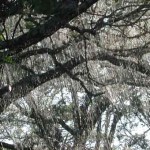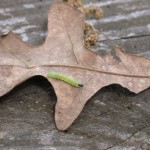San Antonio Express News
GARDENING, Etc.
Sunday, April 24, 2005
By Molly Keck
This past week our office has been overwhelmed with calls from homeowners wondering what are the “little worms falling out of trees” that seem to be plaguing our city. These little critters are actually not worms, but little caterpillars commonly called “oak leaf rollers,” “inchworms,” or “cankerworms.” They spin strands of silk which can wrap entire oak trees when infestations are severe. They are most commonly found in oak trees, their preferred host, but can also infest other types of trees.
- Oak Leaf Roller (Photo: Bart Drees, Texas A&M Entomology)
- Oak Leaf Roller (Photo: Bart Drees, Texas A&M Entomology)
This year’s oak leaf rollers are much worse than recent years due to the mild winter and wet year we have enjoyed.
Oak leaf rollers are currently at their population peak and will hopefully start to diminish by the end of April, although some homeowners may not see relief until early May.
Oak leaf rollers are not only capable of defoliating entire oak trees, but many homeowners cannot spend time outdoors without being bombarded by caterpillars falling out of the trees.
It is important to understand that oak trees have been battling outbreaks of oak leaf rollers long before humans intervened. And in many cases, doing nothing is the best solution to the problem.
However, weakened or stressed trees are more susceptible to severe and irreversible damage by oak leaf rollers as well as other insects and may have to be treated with pesticides. And in residential areas, where trees are valued, protection is usually desired.
There are a variety of products available to treat your oak trees. Products that contain Bacillus thruingiensis or Bt will kill only the caterpillars and spare other insects, including beneficial insects. Insecticides with the active ingredient carbaryl are also effective as well as any other product labeled to treat “oakworms” or “caterpillars.” These are typically sprayed into the trees and kill the caterpillars that come in contact with the pesticide.
Treating the grass around the trees may kill off the surviving caterpillars and prevent them from becoming adult moths which will produce next year’s oak leaf rollers.
If you cannot or do not want to spray the trees yourself, a pest control company can do the work for you.
You can spray your trees now to kill oak leaf rollers on them currently, but the best source of control is to spray before the oak leaf rollers reach their population peak. This will help alleviate the problem before it starts. Next year, spray your trees late March or early April, when the caterpillars emerge, before any damage has been done.
For more information on oak leaf rollers, go to the following web links:
http://insects.tamu.edu/extension/publications/E206.pdf
This article was written by Molly Keck, Integrated Pest Management Program Specialist with Texas Cooperative Extension in Bexar County.

